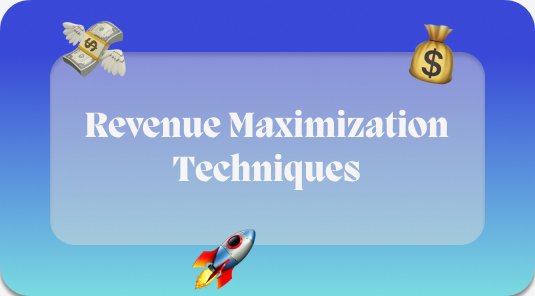The Fundamentals of Data Analysis for Revenue Growth

The Fundamentals of Data Analysis for Revenue Growth: A Clear Guide
Data analysis is a critical component of revenue growth for any organization. With the increasing amount of data available, companies that can effectively analyze and leverage data have a competitive advantage over those that cannot. In this article, we will explore the fundamentals of data analysis for revenue growth, including how to use data analytics to optimize sales and marketing, pricing, and strategic business decisions.

Understanding revenue growth is essential to any business seeking to expand. Data analytics plays a critical role in identifying areas of opportunity for revenue growth. By analyzing customer behavior, market trends, and other factors, businesses can identify opportunities to increase revenue and gain a competitive advantage. Data analytics can also be used to identify potential risks and threats to revenue growth, allowing companies to take proactive measures to mitigate these risks.
Data analytics is not only useful for identifying opportunities for revenue growth but also for optimizing sales and marketing efforts. By analyzing customer behavior and preferences, businesses can tailor their sales and marketing efforts to better target their audience. Pricing is also a critical lever for revenue growth, and data analytics can help identify the optimal price point for products and services. Finally, data analytics can inform strategic business decisions, such as expansion into new markets or product lines, allowing businesses to make informed decisions that drive revenue growth.
Key Takeaways
- Data analysis is critical for revenue growth and gaining a competitive advantage.
- Data analytics can be used to optimize sales and marketing efforts, pricing, and strategic business decisions.
- Proactive risk management and future-proofing are essential for sustained revenue growth.
Understanding Revenue Growth
Key Metrics and Indicators
To understand revenue growth, it is essential to track and analyze key metrics and indicators. These metrics can help identify growth opportunities and areas for improvement. Some of the key metrics to track include:
- Revenue: This is the total amount of money generated by a business over a specific period.
- Gross profit margin: This is the percentage of revenue that remains after deducting the cost of goods sold.
- Customer acquisition cost: This is the cost of acquiring a new customer.
- Customer lifetime value: This is the total amount of revenue a customer is expected to generate over their lifetime.
Tracking these metrics can help businesses identify which areas of their operations are driving revenue growth and which areas may need improvement.
Revenue Growth Management Fundamentals
Revenue growth management is the process of identifying and executing strategies to drive revenue growth. To effectively manage revenue growth, businesses need to:
- Understand their target market: Understanding the needs and preferences of their target market can help businesses identify growth opportunities and tailor their strategies accordingly.
- Optimize pricing: Setting the right price for products or services can help businesses maximize revenue and profitability.
- Improve customer retention: Retaining existing customers is often more cost-effective than acquiring new ones. Improving customer retention can help businesses increase revenue over time.
- Invest in marketing and sales: Investing in marketing and sales can help businesses attract new customers and increase revenue.
By implementing these fundamentals, businesses can effectively manage revenue growth and achieve long-term financial performance.
Data Analytics in Revenue Growth
Data analytics is a crucial tool for businesses to leverage data insights to improve revenue growth. With the rise of big data, businesses can now analyze vast amounts of data to identify trends and patterns that can help them make informed decisions.
Descriptive vs Predictive Analytics
Descriptive analytics is the process of analyzing historical data to identify trends and patterns. This type of analytics is useful for understanding what has happened in the past and can help businesses make informed decisions based on historical data.
On the other hand, predictive analytics is the process of using data, statistical algorithms, and machine learning techniques to identify the likelihood of future outcomes based on historical data. This type of analytics is useful for predicting future trends and can help businesses make informed decisions about future strategies.
Advanced Data Analytics Techniques
Advanced data analytics techniques, such as machine learning and artificial intelligence, can help businesses analyze vast amounts of data to identify trends and patterns that may not be visible through traditional analytics methods. These techniques can help businesses make more informed decisions based on data insights.
By leveraging advanced data analytics techniques, businesses can gain a competitive advantage by identifying new opportunities for revenue growth. For example, businesses can use predictive analytics to identify new market trends and adjust their strategies accordingly.
Overall, data analytics is a powerful tool for businesses to leverage data insights to improve revenue growth. By using both descriptive and predictive analytics, as well as advanced data analytics techniques, businesses can gain a deeper understanding of their data and make more informed decisions based on data insights.
Leveraging AI and Machine Learning
Artificial intelligence (AI) and machine learning (ML) are rapidly transforming the way businesses approach data analysis for revenue growth. By leveraging these technologies, companies can gain valuable insights into market trends and customer behavior, leading to more effective pricing strategies and increased revenue.
AI in Market Analysis
AI is particularly useful in market analysis, where it can be used to identify patterns and trends in large datasets. By analyzing customer behavior and preferences, businesses can gain a better understanding of what drives their revenue and how to optimize their pricing strategies. For example, AI can be used to identify which products are most popular among different customer segments, which can be used to inform pricing decisions.
Another way that AI can be used in market analysis is through sentiment analysis. By analyzing customer feedback on social media and other channels, businesses can gain valuable insights into how customers perceive their brand and products. This information can be used to make data-driven decisions about pricing and marketing strategies.
Machine Learning for Pricing Strategy
Machine learning algorithms are particularly useful for developing pricing strategies. By analyzing large datasets, machine learning algorithms can identify patterns and relationships that would be difficult for humans to spot. For example, machine learning can be used to identify which pricing strategies are most effective for different customer segments, or to predict how changes in pricing will impact revenue.
One of the key benefits of machine learning for pricing strategy is that it can be used to optimize prices in real-time. By analyzing customer behavior in real-time, machine learning algorithms can adjust prices to maximize revenue. This can be particularly useful in industries where prices are highly competitive, such as e-commerce.
In conclusion, AI and machine learning are powerful tools for data analysis that can help businesses make data-driven decisions about pricing and revenue growth. By leveraging these technologies, companies can gain valuable insights into market trends and customer behavior, leading to more effective pricing strategies and increased revenue.
Sales and Marketing Optimization
Effective Promotion Strategies
One of the most important aspects of sales and marketing optimization is developing effective promotion strategies. This involves identifying the target audience, understanding their needs and preferences, and tailoring the promotion to meet those needs.
McKinsey suggests that companies should focus on creating personalized promotions that are relevant to the customer's interests. This can be achieved through the use of customer data analysis, which helps identify patterns and trends that can be used to create targeted promotions.
Another effective strategy is to use social media platforms for promotions. Social media allows companies to reach a wider audience and engage with customers in real-time. Companies can also use social media to gather customer feedback, which can help improve future promotions.
Maximizing Sales Data
Effective sales data analysis is critical for optimizing revenue growth. Companies need to collect and analyze data from various sources, including sales data, customer data, and market data. This data can be used to identify trends, patterns, and opportunities for growth.
One effective way to analyze sales data is to use data visualization tools. These tools allow companies to create interactive dashboards that display sales data in a clear and concise manner. This makes it easier for managers to identify areas of improvement and make data-driven decisions.
Another important aspect of sales data analysis is identifying key performance indicators (KPIs). KPIs are metrics that help measure the success of a promotion or campaign. By tracking KPIs, companies can quickly identify areas of improvement and make necessary adjustments.
In conclusion, effective sales and marketing optimization requires a deep understanding of the target audience, a focus on personalized promotions, and a commitment to data-driven decision-making. By leveraging the power of data analysis, companies can identify opportunities for growth and maximize revenue.
Pricing as a Growth Lever
Pricing is a crucial aspect of revenue growth, and businesses can leverage it to drive growth. A well-designed pricing strategy can help businesses manage margins, optimize discounts, and increase net revenue. In this section, we will explore two pricing models that businesses can use to achieve revenue growth.
Dynamic Pricing Models
Dynamic pricing models are a popular pricing strategy used by businesses to increase revenue. This pricing model involves adjusting prices based on real-time market conditions, customer behavior, and other factors. By doing so, businesses can optimize pricing to maximize revenue and profitability.
Dynamic pricing models are especially useful for businesses that operate in highly competitive markets. For example, airlines use dynamic pricing to adjust ticket prices based on demand, time of the year, and other factors. This pricing model helps airlines manage inventory and maximize revenue.
Discount and Margin Management
Discount and margin management is another pricing strategy that businesses can use to drive revenue growth. This pricing model involves optimizing discounts and margins to maximize net revenue and ROI.
Businesses can use discount and margin management to incentivize customers to make purchases while maintaining healthy margins. For example, businesses can offer discounts to customers who make bulk purchases or to customers who have been loyal to the business for a long time.
Margin management is also crucial for businesses looking to drive revenue growth. By optimizing margins, businesses can increase net revenue and profitability. For example, businesses can reduce costs by negotiating better prices with suppliers or by optimizing their supply chain.
In conclusion, pricing is a critical aspect of revenue growth, and businesses can leverage it to drive growth. By using dynamic pricing models and discount and margin management, businesses can optimize pricing to maximize revenue and profitability.
Strategic Business Decisions
In today's rapidly changing business landscape, companies must make strategic decisions to drive revenue growth. Data analysis has become an essential tool for making informed decisions that help companies stay ahead of the competition. In this section, we will discuss two critical strategic business decisions that companies can make using data analysis.
Mergers and Acquisitions (M&A)
Mergers and acquisitions (M&A) are a popular way for companies to achieve growth quickly. Data analysis can help companies identify potential M&A targets and evaluate the potential benefits and risks of a merger or acquisition. By analyzing financial data, market trends, and customer behavior, companies can make informed decisions about whether to pursue an M&A deal.
Data analysis can also help companies integrate the acquired company into their existing operations smoothly. By analyzing customer data, companies can identify cross-selling opportunities and optimize their product offerings to meet the needs of both sets of customers.
Innovation and Business Model Adaptation
Innovation and business model adaptation are essential for companies to stay competitive in today's market. Data analysis can help companies identify new market opportunities and develop innovative products and services that meet the needs of their customers.
By analyzing customer data, companies can gain insights into customer behavior and preferences, which can inform product development and marketing strategies. Companies can also use data analysis to monitor market trends and identify emerging technologies that can help them stay ahead of the competition.
In addition to developing new products and services, data analysis can also help companies adapt their business models to changing market conditions. By analyzing financial data and market trends, companies can identify areas where they can reduce costs and optimize their operations to improve profitability.
Overall, data analysis is an essential tool for making informed strategic business decisions. By using data analysis to evaluate potential M&A deals, identify new market opportunities, and adapt their business models, companies can drive revenue growth and stay ahead of the competition.
Risk Management and Future Proofing
Identifying and Mitigating Threats
One of the most crucial aspects of data analysis for revenue growth is risk management. The process of identifying and mitigating threats is essential to ensuring the long-term success of any business. In today's rapidly changing business landscape, it is imperative to stay ahead of potential risks and threats that may impact revenue growth.
To identify potential threats, businesses must conduct a thorough risk assessment. This involves analyzing internal and external factors that may impact revenue growth. Internal factors may include operational inefficiencies, while external factors may include economic downturns, changes in regulations, and pandemics.
Once potential threats have been identified, businesses must develop strategies to mitigate them. This may involve implementing new processes, investing in new technology, or diversifying revenue streams. By proactively addressing potential risks, businesses can minimize the impact on revenue growth.
Planning for Long-Term Success
In addition to risk management, future-proofing is another critical aspect of data analysis for revenue growth. Future-proofing involves planning for long-term success by implementing scalable solutions that can adapt to changing business needs.
One way to future-proof revenue growth is by investing in scalable technology solutions. This may include implementing cloud-based data analysis tools that can handle large amounts of data and provide real-time insights. By leveraging scalable technology solutions, businesses can ensure that their data analysis capabilities can keep up with their growth.
Another way to future-proof revenue growth is by fostering a culture of data-driven decision-making. This involves empowering employees at all levels to use data to make informed decisions. By encouraging a data-driven culture, businesses can ensure that they are making decisions based on accurate and timely information, which can lead to increased revenue growth.
Conclusion
In conclusion, risk management and future-proofing are critical components of data analysis for revenue growth. By identifying and mitigating potential threats and planning for long-term success, businesses can ensure that they are well-positioned to achieve sustainable revenue growth.
Stay up to date with our blog
Dive into our informative and engaging blog posts to stay informed on the latest trends in the Webflow & Shopify world as well on actionable tips to make your website work for you.



Contact us
We're only 1 email, call, message or meeting away. We'd be happy to help with your query. Book in a time on our calendar so we can speak.




